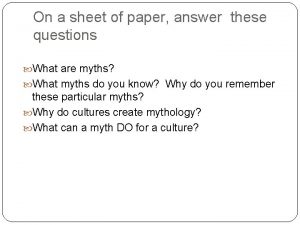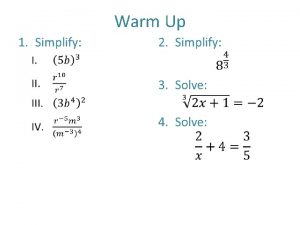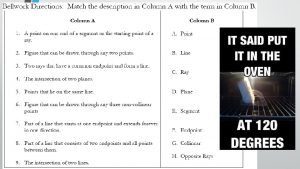Warm Up Write the questions and your answers















- Slides: 15

Warm Up Write the questions and your answers on a blank sheet of notebook paper. 1. List three lab safety rules you already know. 2. What kind of topics do you think that we study in biology?

Lab Equipment Gallery Walk • • Pipette Tongs Microscope Goggles Test tube rack Test tube Graduated cylinder Probe • • Forceps Beaker Erlenmeyer flask Petri dish Slide cover Hot plate

WARM UP FINISH THE SPONGEBOB SIDE OF YOUR SCIENTIFIC METHOD WORKSHEET FROM YESTERDAY! WE WILL HAVE A FIRE DRILL TODAY: TURN LEFT OUT THE CLASSROOM. THEN WHEN YOU GET TO THE MALL TURN LEFT TO GO OUT TO THE TENNIS COURTS!

WARM UP An experiment was designed to investigate the effect of caffeine on heartbeat in water fleas. Two populations had all conditions alike except the fleas in population one had caffeine administered five minutes before their heart beat was checked. Every two hours both populations were selected and heartbeats were monitored. 1. 2. 3. 4. What is the independent variable in the experiment? What is the dependent variable in the experiment? Which group was the control? What was the scientific question?

Graphing

Tables are used to neatly organize data before placing in a graph. Create a table from the following information: A biology studying a plot of land in a forest studied the 5 different type of trees in the plot. Oak- 539 Maple- 758 Beech- 319 Birch- 1, 327 Hickory- 222

• Graphs - show numerical information in a useful format. • three main types of graphs: – circle graphs – line graphs – bar graphs

Circle Graphs/Pie Chart Shows different parts of the data in relation to all the data. Useful in depicting percentages.

Bar Graph A bar graph is used to show data that are not continuous. Often used for comparisons.

Line graphs Used to demonstrate continuous change.

When creating a bar or line graph: • The independent variable is put on the horizontal (x) axis • The dependent variable is put on the vertical (y) axis • Label your axis and give the graph a title • Use an appropriate scale on each axis. For example, 1 cm = 10 years so, 3 cm = 30 years • Use the whole page!


Let’s Practice • What kind of graph should we create from the following set of data: Date Amount of Precipitation (cm) Aug 1 0. 5 Aug 2 0. 0 Aug 3 1. 0 Aug 4 0. 25 Aug 5 1. 25 Aug 6 0. 0 Aug 7 0. 0 Aug 8 0. 75 Aug 9 1. 75

Let’s Practice. Year Population (in millions) 1881 50. 2 1890 62. 9 1900 76 1910 92 1920 105. 7 1930 122. 8 1940 131. 7 1950 151. 3 1960 179. 2 1970 203. 2 1980 226. 5 1990 251. 4

Extrapolate The process of going beyond the data points. The further from the data points we extrapolate the less accurate our findings. 1. Predict what the population of the US will be in the year 2010. 2. Can you be as certain for this prediction as you were for a prediction for the year 2000? 3. Use the graph to determine the approximate population in 1935, 1945, 1985.
 In your notebook write questions and answer them
In your notebook write questions and answer them Answer the question write your answer on your notebook
Answer the question write your answer on your notebook In your notebook write which article
In your notebook write which article In your notebook write down the times
In your notebook write down the times In your notebook write question and answer
In your notebook write question and answer Warm up questions and answers
Warm up questions and answers Look at each of the pictures and answer the questions
Look at each of the pictures and answer the questions Write questions and answers
Write questions and answers On a sheet of paper answer the following questions
On a sheet of paper answer the following questions Example of school magazine article
Example of school magazine article Each proportion write your answer in your notebook
Each proportion write your answer in your notebook How to write a postcard
How to write a postcard Warm up domain range and functions answer key
Warm up domain range and functions answer key Write questions to the following answers
Write questions to the following answers Write answers that are true for you
Write answers that are true for you In your notebook write down or draw the one you would
In your notebook write down or draw the one you would




























